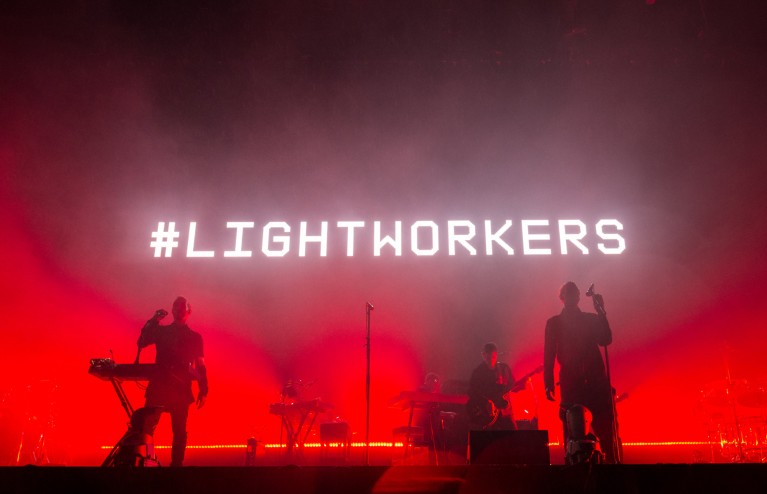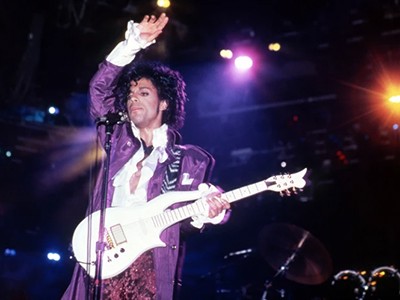
Live music is a major carbon emitter — by changing its practices, it can galvanize change elsewhere.Credit: Simon Chapman/LNP/Shutterstock
On 25 August, the band Massive Attack performed to around 34,000 fans as part of an all-day live music festival in Bristol, UK. Nothing unusual in that — in many parts of the world, summer calendars are packed with such events. But this festival, Act 1.5, aspired to be something different. Billed as a “climate action accelerator”, it was the culmination of a five-year collaboration between Massive Attack and scientists at the Tyndall Centre for Climate Change Research at the University of Manchester, UK, to decarbonize the live music industry.
Such efforts are much needed. Live performances are an increasingly important source of revenue for artists, and audiences love them, too: the multinational company Live Nation Entertainment reports that more than 145 million fans attended its over 50,000 events worldwide in 2023, a record. For every one, temporary sets must be constructed, venues supplied with energy, and performers, equipment and audiences transported, often over large distances.

Massive Attack’s science-led drive to lower music’s carbon footprint
US singer Taylor Swift’s ongoing Eras Tour alone consists of 152 shows across 5 continents in 21 months. In 2010, researchers used figures from 2007 to estimate that the UK music industry produced some 540,000 tonnes of greenhouse-gas emissions annually, around 0.1% of the country’s total energy-related carbon dioxide emissions. Live music accounted for 74% of that (C. Bottrill et al. Environ. Res. Lett. 5, 014019; 2010). Those figures are likely to have risen.
Many in the music industry are riffing ever more loudly on sustainability — in no small measure because of pressure from their fan bases. Kpop4planet, a campaign group run by fans of South Korean K-pop music, successfully petitioned the South Korean car maker Hyundai — for which the members of the K-pop supergroup BTS act as brand ambassadors — to scrap a coal-plant-powered supply deal in Indonesia. Radiohead, Coldplay, Billie Eilish and The 1975 are just some of the high-profile Western stars who have declared initiatives to make live events more sustainable.
These initiatives have not always met with the approval of climate campaigners. When Coldplay was criticized for a biofuel partnership with a Finnish oil company in 2022, for example, the band described its efforts on sustainability as a “work in progress”. One common criticism, says Kyle Devine at the University of Oslo, who researches the environmental impact of the music industry, is that bands’ messaging often focuses on the actions of individual fans — for example, encouraging audience members to travel more sustainably, reduce their plastic use by carrying refillable bottles, or eat more plant-based food. When it comes to high-energy aspects of touring, such as stage power requirements and artists’ travel, the preferred solution is often offsetting, rather than reducing, emissions.

Sounds of science: how music at work can fine-tune your research
Massive Attack’s collaboration with Carly McLachlan and her colleagues at the Tyndall Centre started from the premise that low-carbon practices should be the backing track to all aspects of staging live music. The resulting roadmap, published in 2021 (see go.nature.com/3xdyq5j), set out emissions-reduction targets for the UK live music industry in line with the 2015 Paris climate agreement. Its recommendations focus on curbing emissions in energy use, audience and artists’ travel, and sundry areas such as food and drink supply — all principles applied to the Act 1.5 festival, as a Careers Feature in Nature details. At the end of this year, the researchers will report on how sustainable and replicable such events are in practice for both organizers and attendees.
Other initiatives also signal a shift in how the industry thinks about sustainability, says Devine. This year, the organizers of 36 arts festivals from across 8 Caribbean and Latin American countries joined together through the Cultura Circular Programme to discuss reducing the events’ environmental impact. The Climate Machine research group, part of the Massachusetts Institute of Technology’s Environmental Solutions Initiative, has undertaken a project co-funded by the Warner Music Group, Live Nation and Coldplay to analyse the carbon footprint of the live music industry, initially in the United Kingdom and United States, and suggest practical mitigating measures. That should be published in late 2025, says the group’s co-leader Norhan Bayomi, an environmental scientist and DJ.

The neuroscientist formerly known as Prince’s audio engineer
Some real change has already been achieved. In 2023, for the first time, the long-running Glastonbury Festival in the United Kingdom was powered solely by fossil-fuel-free grid electricity combined with solar photovoltaic and battery hybrid systems. In June 2024, Coldplay announced that direct emissions from its current world tour were almost 60% lower than those of its 2016–17 stadium tour, with 18 shows powered entirely by portable battery systems and 72% of all waste diverted from landfill.
Historically, music has played a key part in social movements. The industry now has the chance to be a role model for real change — and audiences are receptive. In a survey of 350,000 live music fans across the United States, 72% said climate change is an important issue and 70% did not oppose artists speaking out about it (see go.nature.com/474sh69). And a 2022 report by researchers at the University of Glasgow, UK, found that music fans are more likely to care about climate change than are non-music fans (see go.nature.com/3x9drao).
Some might say that live music is, by its nature, unsustainable, and that the best solution would be for performers to stop touring altogether. But that is a joyless answer — and there is an alternative. Richard Betts, a meteorologist and climate scientist at the University of Exeter, UK, thinks that change will come only when it is driven by those highest up in the music industry and backed by good science. Now is the time to be vocal.
